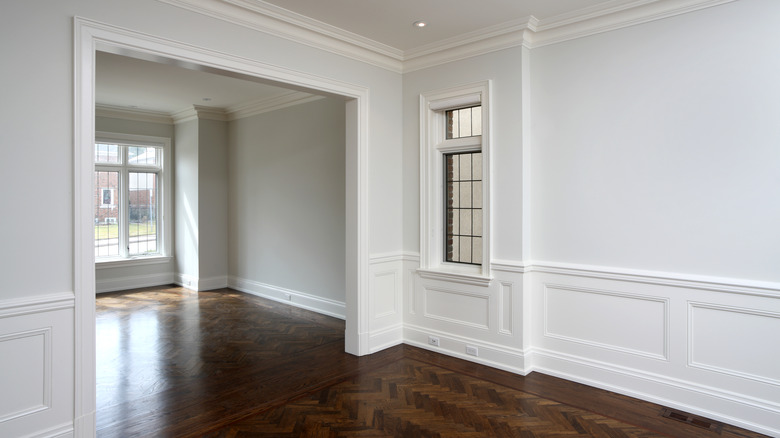The Bizarre Home Feature Even The Property Brothers Can't Wrap Their Heads Around
Drew and Jonathan Scott have seen many odd features when renovating homes on their HGTV show "Property Brothers." However, among the weirdest seems to be a fixture in Las Vegas homes. "One of the weirdest things that I see all the time in Vegas are the tiny baseboards," Jonathan Scott said in the seventh episode of "Property Brothers" season 14. "These are the thong of baseboards," Drew Scott agreed. "They're too-string-like." The baseboards in the home the pair are showing their clients seem more like thin molding than the traditional thick baseboards. This odd baseboard option seems to be closer to quarter-round molding, which is often used to cover the space where the floor meets the wall.
Quarter-round molding can sometimes be used with larger, more substantial baseboards for a layered look or, as stated, to cover gaps. However, they're not often used alone as baseboards. These smaller molding pieces, especially because of their rounded finish, contribute to the home's outdated style. And the small profile doesn't fit with the large open living room that they're in. Ultimately, it's no wonder that the Property Brothers wanted to remove this feature from the home.
How large should baseboards be?
One of the major complaints about the small baseboards was that they didn't fit with the scale of the room. "You need something a little more substantial to be impressive in this space, especially when your walls are so big," Drew Scott explained, referencing the large open living room with high ceilings. The smaller-than-usual baseboards look out of place in such a sizeable space, which begs the question of how tall baseboards should actually be.
Generally, baseboards should be relative to the height of the walls, so the taller the walls, the taller the baseboards should be since the height of the baseboards can help emphasize the height of the walls. One way to calculate a good baseboard height is by converting the height of your ceilings into inches and calculating 7% of that number to give you the approximate baseboard height. For example, 8-foot ceilings are 96 inches, and 7% of 96 is 6.72. This means you can use baseboards about 6.5 inches to 7 inches tall.
You should also consider other trim work in the room, such as crown molding, door trim, and chair rails. In general, crown molding and door and window trims should be slimmer than baseboards. If you have chair railing or other similar trim work on the wall, you may want to opt for smaller baseboards to account for the decorative details.
Can tiny baseboards work?
Jonathan and Drew Scott may be against shorter baseboards in favor of the traditional larger ones. However, are there ways to make a short baseboard work in a room? If you're going for a look that is a little more minimalist, shorter baseboards can help achieve that. A slim, low-profile option won't stand out as much as a taller, more ornate one while also offering a more modern appeal. A 1.063-inch by 1.063-inch square block molding costs $17.88 from Home Depot for a piece that is 96 inches long. These smaller-than-average baseboards can be a great way to create an unobtrusive design while still giving some dimension to a wall. They also still help protect the wall from shoe scuffs and furniture scrapes.
Shorter baseboards are also a good option for small rooms or rooms with lower ceilings, as they increase the amount of wall space and can make them appear taller. While tall baseboards can emphasize height, shorter ones can too. You can emphasize the height of the room by choosing shorter baseboards and no crown molding. However, it's probably best to stick with baseboards that are at least 1 inch tall. These are still short but have some height to them, unlike the quarter-round molding the Property Brothers disliked which was 0.62 inches tall and would probably look out of place in any home design.


